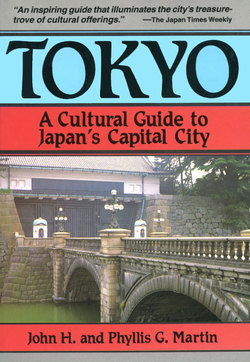Читать книгу Tokyo a Cultural Guide - John H. Martin - Страница 6
На сайте Литреса книга снята с продажи.
ОглавлениеPreface
TOKYO has been a major city for centuries, surpassing in size the great capitals of Europe since the seventeenth century. It is a city which, prior to 1868, had seen the pageant of the shogunate as the daimyo, the great lords of Japan, progressed in state behind their retainers along the Tokaido Road to their sumptuous mansions in the shadow of the shogun's castle. In more modern times, the city has seen the manipulations of the military in their attempt to make Japan a world power by employing the same, and sometimes more brutal, imperialistic means as used by the nations of the West. It has faced as well devastation by earthquakes and by the "Flowers of Edo," those all-consuming fires which have periodically swept over Edo, old Tokyo, and left it but ashes and a memory.
The Edokko, the sons of Edo (and they were mostly sons since men until recent times have always outnumbered women by two to one) have always risen to the challenges which have rained upon the city either by the forces of nature or by the actions and laws of those who ruled over them. Despite the destruction in the twentieth century which has leveled much of Tokyo, first in the Great Kanto Earthquake of 1923 and then in the fire-bombing raids of the spring of 1945 (which in each case left more than 100,000 dead and saw a city of wood disappear in flames), there is a history and a continuity of tradition which has not died. Tokyo since the 1950s has been a rising phoenix. It is a city which offers to visitors one of the most modern facades and boasts towering skyscrapers which, it is claimed, can withstand future earthquakes. Yet past traditions are retained despite all the modernism of the second half of the twentieth century.
It is the intention of this volume to explore present-day Tokyo through a series of "tours" that have a view on the past, whose memory still lingers in the urban life of this ever-changing city. This guide is designed to explore the various intriguing areas of Tokyo on foot, describing the buildings and the history behind them. It does not offer a compendium of restaurants (which can be found at every hand) or shops, with their infinite variety of fine or inexpensive wares. On a few occasions particular department stores or specialty shops will be mentioned, for these cannot be ignored in areas such as Ginza, Shibuya, or Shinjuku, but the listing is not meant to be comprehensive. Museums are noted in the course of a tour, but many of these require a separate visit in order to enjoy their extensive holdings. Each tour is so organized that one may leave it at a specific subway station and then return at another time if a tour is longer than desired.
Part of the pleasure of walking in Tokyo comes from viewing the architectural variety expressed in many of the unusual structures within the city. In the last quarter of the twentieth century, Japanese architects (and some foreign architects with Tokyo commissions) became more imaginative and daring in their architectural designs. Experimentation, innovation, creativity, and sometimes even extravagant conceptions have appeared on the face of the city. Witness the facade on one building on Meiji-dori near Togo Shrine which has a jagged crack built into its construction, as though it had been damaged by an earthquake. Or view the building near Ebisu Station whose lower facade is seemingly missing, again as though a cataclysmic stroke had exposed a portion of the inner building.
The purpose of Tokyo: A Cultural Guide is to bring to life the continuing pageant of historic Edo which lives on in today's Tokyo and which can always surprise and delight those who are willing to explore it on foot and by subway. In some cases a tour can be covered in more than one visit. On the other hand, more than one of these tours can be combined, depending on the time one spends along the way. Before striking out into "unknown territory," one can always purchase sandwiches from the many convenience stores in order to have a picnic lunch en route at a park or shrine. These stores can also provide food for breakfast or dinners should one find restaurant or hotel dining too expensive.
No book on Tokyo, nor any individual who is interested in the capital of Japan as a living city with its roots in the past, can afford to ignore the scholarly yet popular volume by Paul Waley in his Tokyo Now and Then or Edward Seidenstecker's Low City, High City and Tokyo Rising, or Sumiko Enbutsu's Old Tokyo. These volumes are essential reading for anyone wishing further information on a most fascinating city. Additional reading materials are listed in the Bibliography at the end of this volume.
